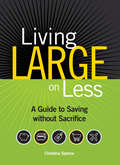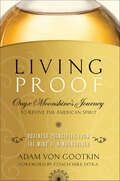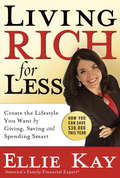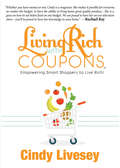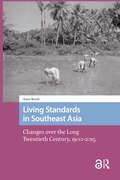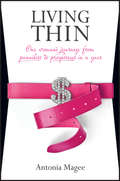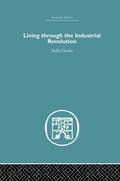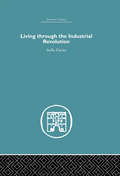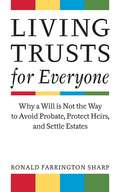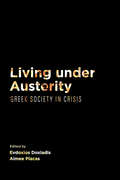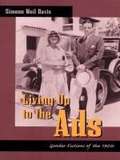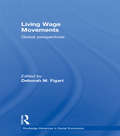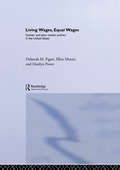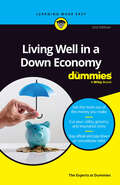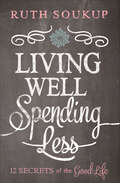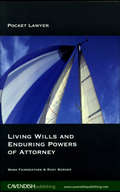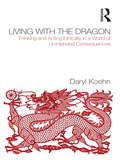- Table View
- List View
Living Large On Less: A Guide to Saving without Sacrifice
by Christina SpenceHave it All—for Half the PriceYou work hard for your money. Wouldn't you like to get more for it? Living Large on Less is full of hundreds of ways to save money without drastically altering your lifestyle. You can eat the food you want, wear your favorite designer's clothes, take a dream vacation and throw a great party without breaking the bank. With this advice, you'll never pay full-price again.Inside you'll find:Practical, easy-to-implement ways to save serious money on everyday expenses, from groceries to housing to transportationFun, creative ideas for saving on luxuries, from fine dining to high fashion to travelSimple, step-by-step instructions for setting and sticking to a budgetEffective strategies for defeating debtYou don't have to be a financial whiz (or even mathematically inclined) to manage your money. And you don't have to sacrifice all the things you love to save some cash. Just follow the simple ideas inside and you'll make your money stretch farther than you ever dreamed. And think of what you can do with that extra dough—pay off debt, finance an education, buy a house, or even retire early. Whatever your motivation, it's never too early (or too late) to start living large on less.
Living PlanIT
by Robert G. Eccles Amy C. Edmondson Susan Thyne Tiona ZuzulLiving PlanIT is a start-up company that has developed a new, innovative business model for sustainable urbanization. This model reflects the software and technology backgrounds of its founders, Steve Lewis and Malcolm Hutchinson, and is in vivid contrast to other models for green or smart cities that are variations on a massive real estate development project. The main economic engine driving Living PlanIT's model is a partner channel strategy adopted from the high technology industry. The case shows how the Living PlanIT business model has evolved from the original vision of Lewis and Hutchinson to radically transform the construction industry to a go-to-market partnership model using the real estate as a "showroom" for evolving sustainable urban technology--a $3 trillion global market over the next 20 years. Living PlanIT is developing its first project, a new city called PlanIT Valley, outside of Porto, Portugal. The company has clarified its vision and is moving into the implementation phase, which involves fundraising, signing up channel partners, and negotiating various issues with the Portuguese government for its pilot project. Success in PlanIT Valley will translate into a strong market position as global population and demand for new cities increases, particularly in developing countries such as China and India.
Living Proof: Are We a Technology Company or a Beauty Company?
by Willy ShihJon Flint came up with the idea of a science-based beauty company while talking with his hairdresser about the problems with typical hair and skin care products. Together with a small team that included Professor Robert Langer of MIT, he committed to assemble a team of scientists from outside the beauty industry to challenge the conventional wisdom. Their company, Living Proof, wanted to offer women "proof in a bottle" rather than "hope in a bottle." As the firm came to market with its first products, it focused on explaining its science to consumers. It found it increasingly necessary to direct more of its resources towards marketing, including a major investment in Jennifer Aniston as its celebrity spokesperson. Were they becoming less of a biotech company and more like a traditional beauty company? How did they reconcile the desire for continued high spending on R&D with the need to ramp up marketing?
Living Proof: Are We a Technology Company or a Beauty Company?
by Willy ShihJon Flint came up with the idea of a science-based beauty company while talking with his hairdresser about the problems with typical hair and skin care products. Together with a small team that included Professor Robert Langer of MIT, he committed to assemble a team of scientists from outside the beauty industry to challenge the conventional wisdom. Their company, Living Proof, wanted to offer women "proof in a bottle" rather than "hope in a bottle." As the firm came to market with its first products, it focused on explaining its science to consumers. It found it increasingly necessary to direct more of its resources towards marketing, including a major investment in Jennifer Aniston as its celebrity spokesperson. Were they becoming less of a biotech company and more like a traditional beauty company? How did they reconcile the desire for continued high spending on R&D with the need to ramp up marketing?
Living Proof: Onyx Moonshine's Journey to Revive the American Spirit
by Adam von GootkinLiving Proof tells the story of how, in just a few short years, Connecticut natives Adam and Pete took Onyx Spirits Company from a start-up concept born in a restored Civil War-era factory to a multimillion-dollar, award-winning spirit distillery by breaking rules, learning from failures, and challenging the status quo.Business lessons distilled from the mind of a moonshiner include:Finding your purpose in business (and life).Setting goals, reaching goals—then setting more goals.Founding a small business and growing it into a big company.Building a highly unique brand.Making money out of thin air (almost).Adam’s ancestors were arrested in 1864 for tax evasion on a shipment of moonshine bound for Canada, resulting in the collapse of Chafee & Co. Distilling. Undaunted by their demise, the family opened the grand Chafee’s Hotel in Middletown, Connecticut, at the dawn of the Roaring twenties, hosting an opulent and infamous speakeasy. The family legacy continues today with Onyx Moonshine.
Living Rich for Less: Create the Lifestyle You Want by Giving, Saving, and Spending Smart
by Ellie KayYou really can be rich in every way, every day. So you want to own the home you love, make memories on wonderful vacations with family or friends, finance college educations, and help others too? You can–starting here and now. With lively humor, proven know-how, and practical principles for financial health,Living Rich for Lesshelps you stretch your dollars to realize the lifestyle of your dreams. Ellie Kay’s entertaining and enlightening examples show you simple steps to save, spend, and give smart, and her three main principles are undergirded by dozens of effective rules and hundreds of Cha-Ching Factor™ tips that keep or put money in your pocket. Ellie knows what it’s like to be financially-strapped or struggling, wanting to be the Joneses but feeling as poor in spirit as in pocketbook. She went, within two and a half years, from being a new wife and mom with $40,000 in consumer debt and seven children (and college educations) to support, to being completely debt-free and within fifteen years able to pay cash for eleven different cars, give away three of those cars, buy two five-bedroom houses (moving from one to the other) and nicely furnish each, take wonderful vacations, dress her family in fine fashion; and support more than thirty non-profit organizations in more than a dozen different countries, giving away more than $100,000. Isn’t that the kind of transformation to a rich life thatyouwant? Living Rich for Lesshelps anyone get there in our taxed-out, maxed-out times. Because financial security doesn’t mean just genuine prosperity, but being able to live luxuriously, give generously, and care for yourself as well as the others around you. Why keep up with the Joneses when you can be them? From the Hardcover edition.
Living Rich with Coupons: Empowering Smart Shoppers to Live Rich
by Cindy Livesey<p>Entering the crazy world of couponing can literally change your life and your lifestyle! You’ll start making ends meet, pay off your debt, create a financial cushion, and feel freer and happier than you’ve felt in years, maybe decades. That’s living rich with coupons! <p>Use the tools you get from this book to build your superpowers. Even Wonder Woman needs her indestructible bracelets, and you’re about to receive yours. It doesn’t matter if you make $15,000 a year or $250,000 a year—everyone needs a budget they can stick to and follow. <p>Cindy helps you to uncover every savings opportunity at your local stores. You’re going to find out exactly what you need to do to save and how to use those coupons correctly.</p>
Living Standards in Southeast Asia: Changes over the Long Twentieth Century, 1900-2015 (Transforming Asia)
by Anne BoothLiving Standards in Southeast Asia: Changes over the Long Twentieth Century, 1900-2015 examines changes in living standards across the ten countries of Southeast Asia (Indonesia, Malaysia, Singapore, Philippines, Thailand, Brunei, Myanmar, Vietnam, Cambodia and Laos) from the early years of the 20th century to the early 21st century. It covers both the last decades of the colonial period, the transition to independence and the decades from 1960 to the 2010s. The study uses a range of monetary and non-monetary indicators to assess how living standards have changed over time. It examines the outcomes in the context of debates about economic growth, inequality and poverty alleviation which began in the 1960s and 1970s, and continue to the present.
Living Thin
by Antonia MageeMaggie Rose is 29, single and perpetually broke. With a weakness for this season's must-haves, good food and good wine, money is something that Maggie spends, not saves.But with mounting credit card debt, her job at the newspaper failing to support her lifestyle and the man of her dreams in love with someone else, Maggie finds herself desperate to tighten her belt and get a healthy relationship with her finances. With the support of her friends, some professional advice and a little thing called eBay, can Maggie change her ways and live thin?Living Thin is a funny and light-hearted tale that will help you learn how to budget, pay off debt and save money... and still have a life!
Living Through the Industrial Revolution
by Stella DaviesFirst published in 1966, this revealing study looks closely into the lives of the men, women and children working in mines, workshops, factories and farms during the industrial revolution. It investigates the inventors whose new machines made the industrial revolution possible, and reflects on the new type of employer whose enterprise and energy in linking machine and labour power formed a new society. Where possible, contemporary accounts, letters, diaries and reports have been used so that the words of those living through this remarkable time can be heard - the words and thoughts of masters, workpeople, apprentice children, 'improving landlords' and farm labourers illuminate the prevailing attitudes of the period. An introductory chapter outlines previous methods of living and working and shows the first movements towards the industrial revolution. Describing successes and failures, lives of impoverishment and hardship, fortunes made and, sometimes, lost, and the effects of the new society, this enlightening study investigates how early struggles to cope with almost overwhelming problems are now seen as the beginnings of the comparatively comfortable conditions we benefit from today.
Living Through the Industrial Revolution
by Stella DaviesFirst published in 1966, this revealing study looks closely into the lives of the men, women and children working in mines, workshops, factories and farms during the industrial revolution. It investigates the inventors whose new machines made the industrial revolution possible, and reflects on the new type of employer whose enterprise and energy in linking machine and labour power formed a new society. Where possible, contemporary accounts, letters, diaries and reports have been used so that the words of those living through this remarkable time can be heard - the words and thoughts of masters, workpeople, apprentice children, 'improving landlords' and farm labourers illuminate the prevailing attitudes of the period. An introductory chapter outlines previous methods of living and working and shows the first movements towards the industrial revolution. Describing successes and failures, lives of impoverishment and hardship, fortunes made and, sometimes, lost, and the effects of the new society, this enlightening study investigates how early struggles to cope with almost overwhelming problems are now seen as the beginnings of the comparatively comfortable conditions we benefit from today.
Living Trusts for Everyone: Why a Will Is Not the Way to Avoid Probate, Protect Heirs, and Settle Estates (Second Edition)
by Ronald Farrington SharpReaders say it best: "Very informative", "saved me a lot of money and headaches!", "recommend it for everyone who has to plan estates for their elderly parents"Living Trusts for Everyone is the best resource for setting up a living trust. Explaining in specific terms what benefits a trust will have, Ronald Farrington Sharp gives the tools necessary to set up a loved one’s trust with no lawyers and no expense. Wills benefit lawyers. Trusts benefit the clients. Too often lawyers sell wills to clients only to sit back and wait to sell their probate services to their clients’ heirs. Ronald Farrington Sharp describes the best way to handle modern estate planning and details the many advantages trusts have over wills in not only eliminating probate but in also protecting your assets for your heirs. Sharp explains why legal services are not needed to do the clerical work in settling a trust after death. This updated edition includes new information on an array of subjects, including:Elimination of the federal estate tax for most estates due to increased exemption amountsOnline assetsThe use of passwords, usernames, and websitesKeeping trustees honest and the process of removing trustees for malfeasanceForms for simplifying the planning processStrategies to lower attorneys’ fees>/li> With no legal jargon, just step-by-step instructions and sample form letters, Living Trusts for Everyone takes the mystery out of the process of setting up a trust.
Living Trusts for Everyone: Why a Will is Not the Way to Avoid Probate, Protect Heirs, and Settle Estates
by Ronald Farrington SharpThe misconceptions surrounding the last will and testament need to be put to rest: Wills benefit lawyers. Trusts benefit you. Period. <P><P>Too often lawyers sell wills to clients only to sit back and wait to sell their probate services to their client' s heirs. Modern estate planning should utilize the Living Trust as the effective, efficient, and inexpensive alternative to a will. Living Trusts for Everyone: Why a Will is Not the Way to Avoid Probate, Protect Heirs, and Settle explains why wills are not the best way to handle an estate and details the many advantages trusts have over wills in not only eliminating probate, but protecting your assets for your heirs. Anyone with minor children, disabled beneficiaries, blended families, or spendthrift heirs must have a trust to be sure the assets left behind are put to good use, and that your intentions are carried out. Lawyers may have vested interests in perpetuating the probate system, but this book will explain why legal services are not needed to do the clerical work in settling a trust after death. No legal jargon or confusing double-speak, just specific step-by-step instructions and sample form letters to settle a trust are included to take the mystery out of the process. This is not a do-it-yourself book and it doesn't try to cram every type of trust onto its pages. Living Trusts for Everyoneexplains in specific terms what benefit a trust will have for you and gives you the tools to settle a loved one's trust with no lawyers and no expense. For those who already have a trust, there is a list of what to look for to see if your trust is any good, or if it needs to be updated. Trust seminars are examined with warnings on what to look out for in setting up your trust. Everyone who cares about what happens to their assets at death should read Living Trusts for Everyone: Why a Will is Not the Way to Avoid Probate, Protect Heirs, and Settle!
Living Under Austerity: Greek Society in Crisis
by Evdoxios Doxiadis Aimee PlacasSince its sovereign debt crisis in 2009, Greece has been living under austerity, with no apparent end in sight. This volume explores the effects of policies pursued by the Greek state since then (under the direction of the Troika), and how Greek society has responded. In addition to charting the actual effects of the Greek crisis on politics, health care, education, media, and other areas, the book both examines and challenges the “crisis” era as the context for changing attitudes and developments within Greek society.
Living Up to the Ads: Gender Fictions of the 1920s
by Simone Weil DavisIn Living Up to the Ads Simone Weil Davis examines commodity culture's impact on popular notions of gender and identity during the 1920s. Arguing that the newly ascendant advertising industry introduced three new metaphors for personhood--the ad man, the female consumer, and the often female advertising model or spokesperson--Davis traces the emergence of the pervasive gendering of American consumerism. Materials from advertising firms--including memos, manuals, meeting minutes, and newsletters--are considered alongside the fiction of Sinclair Lewis, Nella Larsen, Bruce Barton, F. Scott Fitzgerald, and Zelda Fitzgerald. Davis engages such books as Babbitt, Quicksand, and Save Me the Waltz in original and imaginative ways, asking each to participate in her discussion of commodity culture, gender, and identity. To illuminate the subjective, day-to-day experiences of 1920s consumerism in the United States, Davis juxtaposes print ads and industry manuals with works of fiction. Capturing the maverick voices of some of the decade's most influential advertisers and writers, Davis reveals the lines that were drawn between truths and lies, seduction and selling, white and black, and men and women. Davis's methodology challenges disciplinary borders by employing historical, sociological, and literary practices to discuss the enduring links between commodity culture, gender, and identity construction. Living Up to the Ads will appeal to students and scholars of advertising, American studies, women's studies, cultural studies, and early-twentieth-century American history.
Living Wage Movements: Global Perspectives (Routledge Advances in Social Economics #Vol. 58)
by Deborah M. FigartLiving wage activism has spanned time and space, reaching across decades and national boundaries. Conditions generating living wage movements early in the twentieth century have resurfaced in the twenty-first century, only on a global scale: 'sweated' labour, macroeconomic instability, and job insecurity.Upon reviewing the empirical evidence, the book's contributors make strong cases both for and against living wage activism. The effective blend of historical, contemporary, and global perspectives provides opportunities for teachers, scholars, and activists to evaluate how we can address low pay at the organizational and macroeconomic levels.
Living Wages, Equal Wages: Gender and Labour Market Policies in the United States (Routledge IAFFE Advances in Feminist Economics #Vol. 1)
by Deborah M. Figart Ellen Mutari Marilyn PowerWage setting has historically been a deeply political and cultural as well as economic process. This informative and accessible book explores how US wage regulations in the twentieth century took gender, race-ethnicity and class into account. Focusing on social reform movements for living wages and equal wages, it offers an interdisciplinary account of how women's work and the remuneration for that work has changed along with the massive transformations in the economy and family structures.The controversial issue of establishing living wages for all workers makes this book both a timely and indispensable contribution to this wide ranging debate, and it will surely become required reading for anyone with an interest in modern economic issues.
Living Well in a Down Economy For Dummies
by The Experts at DummiesAs the economic pendulum swings, it’s time to start living smart Living Well in a Down Economy For Dummies offers ideas for keeping more money in your pocket during a topsy-turvy economy. With more than 100 tips, it shows you how to tighten your belt without feeling a big pinch in your day-to-day life. Discover innovative and effective ways to cut expenses and boost your income in today’s economy. It isn’t about making sacrifices. It’s about setting priorities. Gain the skills you need to take control of your spending, make smarter choices, and stop the financial drain that can accompany a downturn in the economy. Inside, you’ll find practical advice on how to live and thrive when prices creep up or your income falls. Get tips for spending less in all areas of life—utilities, groceries, pet care, entertainment, and beyond. And figure out how to slip in some self-care without breaking the bank. You can do this, thanks to this no-judgment For Dummies guide. Reduce your expenses by cooking at home, doing your own car maintenance, cutting your own hair, and more Discover creative ways to increase your income, interview for better-paying jobs, and continue to save for college or retirement Save money on home maintenance, insurance, and other reoccurring costs Minimize your tax bill, improve your credit, and avoid foreclosureIf you’re looking for practical tips on how to make ends meet that you can implement today, this For Dummies guide is for you.
Living Well or Even Better on Less
by Ellen KunesFrom the Book jacket: This excellent new source book provides cost-cutting tips on everything from food to furniture to flights overseas. Living Well-or Even Better-on Less covers every area of consumer life, including: Food-shopping, preparation, restaurant ordering, and fast- food bargains Clothing-factory outlets, sales, and personal shoppers Personal finances-monitoring and reducing cash outflow; lowering credit-card finance charges Home furnishings Premium electronics-where to get them; how and when to negotiate prices Entertainment-discounts on movies, concerts, sporting events, personal fitness programs, and activities for children Travel-both basic transportation and vacation excursions Inexpensive indulgences to satisfy expensive impulses With its lists of addresses and phone numbers for more information and money-saving advice. Living Well-or Even Better- on Less is an invaluable consumer resource.
Living Well, Spending Less: 12 Secrets of the Good Life
by Ruth Soukup“If you struggle to simplify your life and wish you could savor the here and now, this book is a must-read.” —Crystal Paine, founder of MoneySavingMom.com and New York Times–bestselling authorHave you ever felt that your life—and budget—is spiraling out of control? Do you sometimes wish you could pull yourself together but wonder exactly how to manage all the scattered pieces of a chaotic life? Is it possible to find balance? In a word, yes. Ruth Soukup knows firsthand how stressful an unorganized life and budget can be. Through personal stories, biblical truth, and practical action plans, she will inspire you to make real and lasting changes to your personal goals, home, and finances. With honesty and the wisdom of someone who has been there, Ruth will help you:Discover your “sweet spot” —that place where your talents and abilities intersect.Take back your time and schedule by making simple shifts in your daily habits.Reduce stress in your home and family by clearing out the clutter.Stop busting your budget and learn to cut your grocery bill in half.This book provides real and practical solutions from someone who has been there. Ruth doesn’t just offer advice, she walks it with you, and shares with brutal honesty her own mistakes, failures, and shortcomings. It is encouraging, motivating, and life-changing.“An inspiring book full of step-by-step instructions and spiritual wisdom. I love how Ruth is transparent about her mistakes as she leads us to reevaluate our priorities. This book is a great biblical guide to living well and finding joy!” —Courtney Joseph, founder of Women Living Well Ministries
Living Wills and Enduring Powers of Attorney (You Need This Book First Ser.)
by Mark Fairweather Rosy BorderThis book allows you to decide whether a living will is for you and offers a plain English living will to make your wishes known and how to grant an EPA allowing those you trust to manage your affairs.
Living Wills and Powers of Attorney for California
by Shae IrvingA serious accident or illness can happen to anyone at any time. That’s why everyone should have these essential documents: An advance health care directive (also called a living will and durable power of attorney for health care), which lets you state your wishes for end-of-life medical care and name a trusted person who will work with your doctors to be sure you get the kind of care you want. A durable power of attorney for finances, which lets you appoint someone you trust to manage your finances for you if you no longer can. The book explains how to create these forms to comply with California law, and how they can be used to help your family. The book also contains instructions for obtaining a Do Not Resuscitate (DNR) order or a Physician Orders for Life-Sustaining Treatment (POLST) form, either of which can be used to let emergency medical responders know that you don’t want certain extreme measures to be used to revive you. Includes forms for both medical care and finances. New edition is fully updated for 2018.
Living Wills and Powers of Attorney for California
by Shae Irving J.D.A serious accident or illness can happen to anyone at any time. That’s why everyone should have these essential documents: An advance health care directive (also called a living will and durable power of attorney for health care), which lets you state your wishes for end-of-life medical care and name a trusted person who will work with your doctors to be sure you get the kind of care you want. A durable power of attorney for finances, which lets you appoint someone you trust to manage your finances for you if you no longer can. The book explains how to create these forms to comply with California law, and how they can be used to help your family. The book also contains instructions for obtaining a Do Not Resuscitate (DNR) order or a Physician Orders for Life-Sustaining Treatment (POLST) form, either of which can be used to let emergency medical responders know that you don’t want certain extreme measures to be used to revive you.
Living Wills and Powers of Attorney for California (3rd edition)
by Shae IrvingHelps Californians create a living will and other legal forms they need to protect their families, property and themselves.
Living With the Dragon: Acting Ethically in a World of Unintended Consequences
by Daryl KoehnThe book consists of a short introduction to the significance of unintended consequences and four chapters. The first chapter develops a typology of unintended consequences and distinguishes them from historical contingencies. The second chapter analyzes three types of causes of such consequences: worldly, practical and psychological causes. The third explores the significant problems these consequences pose for standard moral theories. The fourth and final chapter examines how we might begin both to think about and cope with unintended consequences in an ethically good way.
